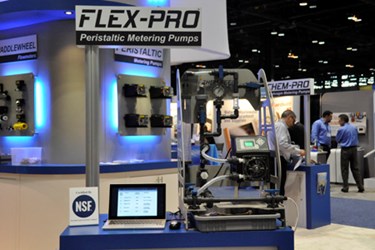Peristaltic Metering Pump Control Leverages The Latest Communications Technology

Bill McDowell, Sales Engineer with Blue White Industries, explains how communications technology is impacting metering pump control and the possibilities that wireless technology will bring.
The following is an excerpt from a Q&A with Water Online Radio. Click on the Radio Player above to hear the full interview.
Water Online Radio: Can you give us more detail on the peristaltic pump from Blue White Industries?
Bill: We have the municipal version of our Flex-Pro® peristaltic metering pump, or the ‘M Series’, and we have a new M2 that we just released this year. The M3 and M4 have been out for about four years now.
Some of the new features of the M2 are communications. We think that there is going to be a big push in communications protocols and being able to speak to these pumps more effectively from SCADA systems. Our product offerings address this trend.
Water Online Radio: Talk about the applications of this technology.
Bill: Peristaltic metering pumps have been around since the Roman days. Basically you are just squeezing the chemical through this pump. The nice thing about it is that it will pump air. It will pump slurries. There are no valves.
It is a very good pump for chlorination and fluoridation, odor control, and alum injection. It’s also a great pump for polymer injection because polymer needs to be pumped slowly. In fact, a lot of polymer blending systems around the tank will have peristaltic pumps inside of them.
Water Online Radio: What are the recent advances in peristaltic pumps that we should be aware of?
Bill: I think the biggest advance was when volcanized rubbers came out. This was about 15-20 years ago. When rubber tubing technology got to the point where it could last a long time, that’s when more peristaltic pumps started to come out.
We also patented a tube failure detection system some 8-10 years ago. The tube failure detection allows our pump to shut off within about three seconds if there is a leak. That technology made it a little safer to use these because they are going to spring a leak eventually. The tube eventually wears out.
Water Online Radio: Earlier, you talked about the communications technology that is getting built into all of these things. I have to believe that from an end-user standpoint and the cost of operating and maintaining these systems, that it has to have pretty significant cost impact. Talk about that for a little bit.
Bill: Yes. I will give you a good example. I was at a water treatment plant at one point and this particular peristaltic pump has four alarm outputs-a remote start/stop, analog input and a total of about 12 different cables that need to be run into that pump to talk to their SCADA system. This particular water plant just didn’t have the room in their conduit to put in anymore cables. These new protocols allow us to put a CAT5 cable, one single cable, and you can get a huge amount of data through the pump through a small cable.
These kinds of technologies now are allowing older plants to be able to have that kind of communications without having to dig up a plant. I think the guy told me he was going to pay $25,000 to dig up a little concrete sidewalk and put in some conduit. It is a big savings when you look at it that way.
Water Online Radio: Talk about the newer technology. I have to think that the possibilities with communications in 35 years are going to be mind-blowing.
Bill: If you can imagine, you have wireless internet now, and pretty soon, I think you are going to start seeing wireless pumps. There are security problems with that right now, so we are not there yet, but we do have an industrial Ethernet connection that is very fast.
The system can talk to the pump and change pump outputs and speeds. At Rancho Cucamonga Water District, the operators are running their pumps and the entire plant off an iPad.
This is where we think things are going. We are trying to stay on top of it.
Water Online Radio: Blue White has a reputation of working with customers to solve their most difficult problems. As you look into the future, what tough issues are trying to help your customers solve?
Bill: One of the tough issues right now is accuracy. Everybody is trying to get more accurate. They want to use less chemical, and they also want pumps that last 10 years. These are chemicals that are 98 percent Sulfuric acid applications. That’s a tough application for a peristaltic meter pump, but we can do that.
Customers need to inject these chemicals very precisely because that will enable the plant to run more accurately. Plants face a lot of pressure to stay in compliance.
The less chemical that they can use to stay in compliance, the better off everybody is-and that includes the environment. I think that is a real struggle right now...
Click on the Radio Player above to hear the full interview.
